A Little Lift
Gliders so responsive they can stay up on a breath of fresh air.
- By Paul Ciotti
- Air & Space Magazine, May 01, 2005
- http://www.airspacemag.com/flight-today/lift.html
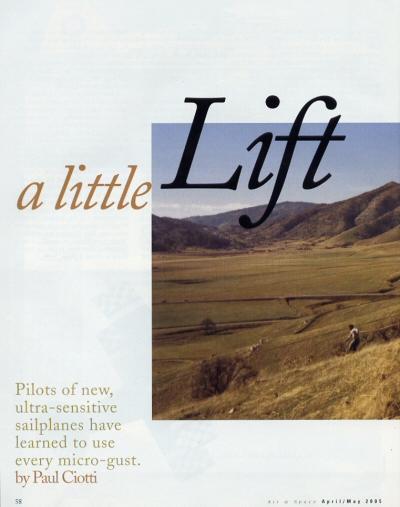
It is shortly after eight in the morning at El Mirage dry lake, a cracked and dusty expanse in the high desert 55 miles northeast of Los Angeles. Despite the big plumes of yellow smoke from wildfires on the far side of the San Gabriel Mountains to the south, up here on the lakebed it is clear and quiet as sailplane designer Danny Howell does a preflight checkout of his ultra-lightweight sailplane, the LightHawk.
“There’s not a straight line on it anywhere,” boasts the Northrop Grumman engineer, sighting the prototype’s gently swelling 15-meter (49 feet) elliptical wings. From above, the wings look more like those of a large seabird than anything you’d see on an airplane. According to Howell, that’s the whole idea: to build an unpowered aircraft that not only imitates the efficiency of soaring birds but also can fly as slowly as they do…in the LightHawk’s case, a mesmerizingly slow 23 mph.
This morning’s flight will be only the seventh time the LightHawk has been in the air, so Howell and his half-dozen crew members are extremely cautious. After a prolonged inspection of the aircraft, Howell gives the go-ahead to test pilot Galen Fisher. Fisher calls the driver of the tow vehicle, 1,800 feet down the lakebed, to tell him to get moving, and in 30 seconds Fisher has risen to 600 feet, where he releases the tow rope, eases into a right turn over the scrub and Joshua trees, and begins to search for rising air.
There’s not much out there this early in the day, and within a few minutes Fisher has fallen to 200 feet and is starting to think about landing when he notices a raven slowly circling nearby. Fisher maneuvers over to join him, and soon they both are slowly rising at a nearly imperceptible hundred feet per minute. The higher they go, the better the lift seems to be, and within half an hour Fisher is cruising comfortably at 8,500 feet, where the sailplane sinks at such a slow rate—Howell estimates just 1.3 feet per second—that in the words of one test pilot, the craft appears to “fly around horizontally.”
At 200 pounds, the LightHawk, which has gone on to make 20 flights, is the latest and most technologically sophisticated entry in an emerging class of low-inertia sailplanes—super-light, super-efficient gliders with such low airspeeds and sink rates that they can stay aloft far longer than every other kind of sailplane. This class includes the 101-pound, Swiss-built, open-cockpit Archaeopteryx, the German-made ULF-1 glider, increasingly efficient rigid-wing hang gliders, and the venerable 145-pound Carbon Dragon, a balsa wood and carbon-fiber sailplane that in recent years has acquired almost mythic status for its unique ability to stay aloft on “micro-lift”—the weak energy that can be extracted from the fleeting gusts, burbles, and meandering air streams found below 1,000 feet.
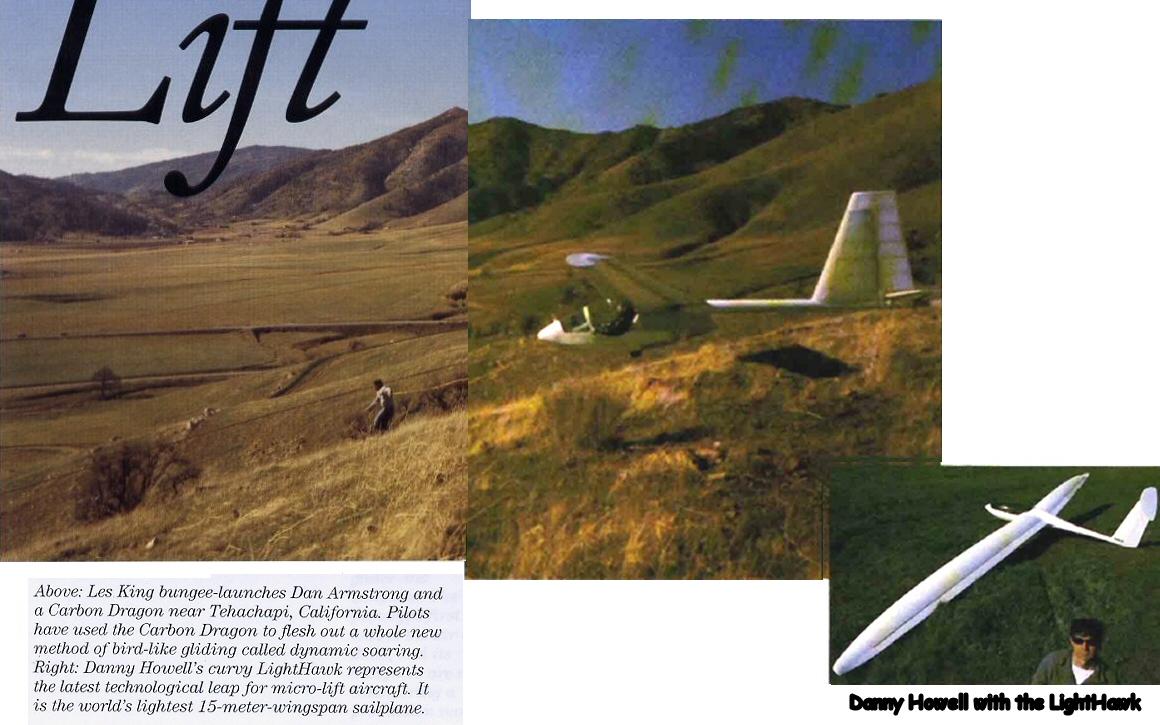
Designer Jim Maupin first conceived of the Carbon Dragon in the late 1970s, when there was no such thing as a low-inertia sailplane. He intended the Carbon Dragon to be a superlight craft that would have the maneuverability of a slow-flying hang glider but the high lift-to-drag ratio of a rigid-wing sailplane.
“His goal was to set a world [distance] record from a foot-launched aircraft,” says Dan Armstrong, a Tehachapi, California-based aeronautical engineer who at the time was one of the young soaring enthusiasts helping Maupin build the sailplane. In time, the sailplane would fulfill the dream; Wichita-based entrepreneur Gary Osoba now owns the prototype, which he has flown to four distance world records and one speed-over-distance record. Its unique characteristics also have opened up a whole new method of soaring. With a 44-foot wingspan, a 1.7-foot-per-second minimum sink rate, a 20 mph stall speed (in contrast to a typical 15-meter ship’s 40 mph), and a roll rate of about 27 degrees per second, the Carbon Dragon was the first sailplane to take advantage of micro-lift, using a technique known as dynamic soaring.
Unlike conventional soaring, in which pilots attempt to lift their sailplanes to higher altitudes by seeking air rising along ridges or in the form of columns called thermals, dynamic soaring provides speed or altitude by exploiting micro-lift and wind gradients—differing rates of movement in neighboring air masses. “You’re looking more to try to bounce off gusts of air and get energy from air that’s much more complex than just [a thermal],” says Taras Kiceniuk Jr., a hang gliding pioneer who has done much to put dynamic soaring on a sound mathematical basis.
Dynamic soaring is not a new idea—“It’s been postulated for over a hundred years,” says Osoba—though it’s gained some exposure in recent years through the exploits of hobbyists who pilot radio-controlled model sailplanes. By flying these gliders in oval patterns between the high winds just above a hill and the still air just behind it, they have been able to turn their sedate models—which normally fly at 25 to 40 mph—into screaming rockets that rip around at up to 230 mph, sometimes tearing their wings off in the process.
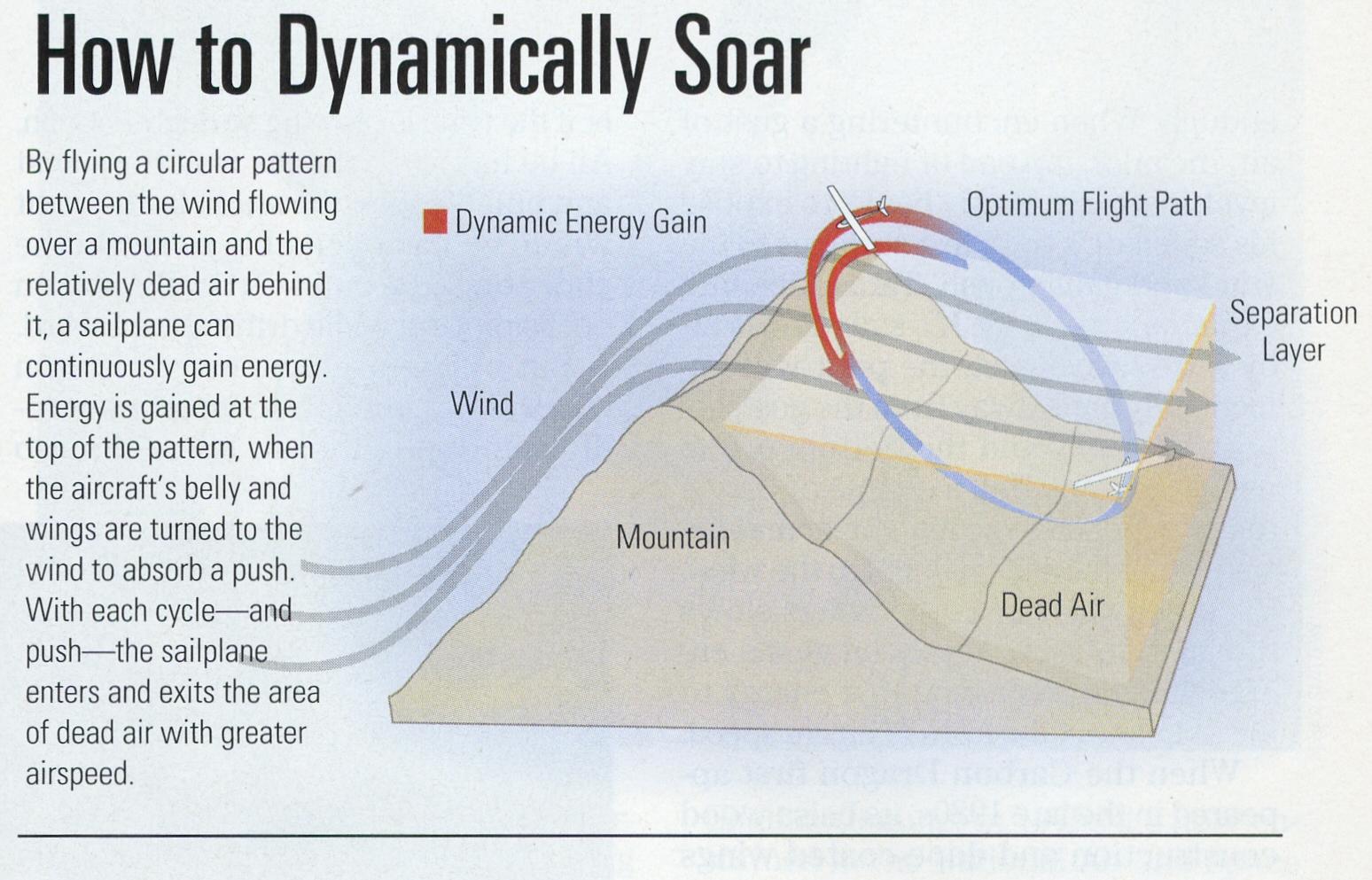
Seabirds have been dynamically soaring for untold eons. For example, albatrosses take off from the ocean’s surface (with a lot of vigorous flapping and running on water with webbed feet), climb to a height of perhaps 30 feet, lock their wings, and thereafter soar back and forth between the near-stationary air near sea level and faster moving air higher up. Each time they rise into the fast moving air, they get a small energy boost that enables them, as they glide back down into the near stationary air, to travel hundreds of miles a day without flapping their wings.
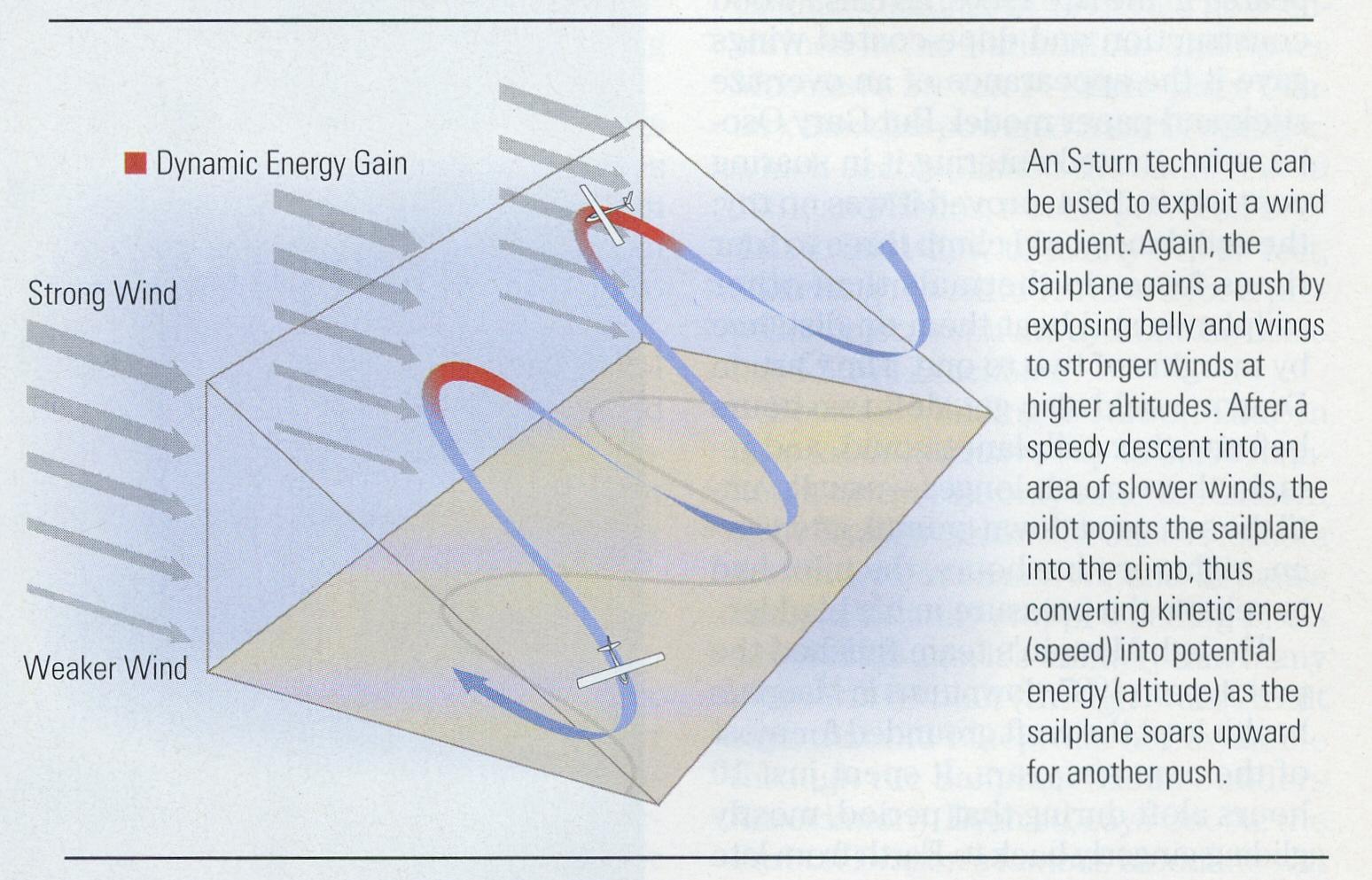
Although staying aloft with dynamic soaring requires considerable technique, its basic maneuvers are simple enough: When encountering a gust of air, the pilot, instead of fighting to stay level, instantaneously banks to expose his sailplane’s broadest surfaces to the wind and gain a push. Taras Kiceniuk explains it this way: If a sailplane is hit by a sideways gust, the pilot will immediately bank away from the gust, expose the belly and the bottom of the wings to it, and pull a couple of Gs. As the pilot finishes the maneuver and the sailplane’s tail slips parallel to the wind, the downwash from the wings slows the gust, thus reducing the gust’s energy while transferring that energy to the sailplane in the form of higher speed.
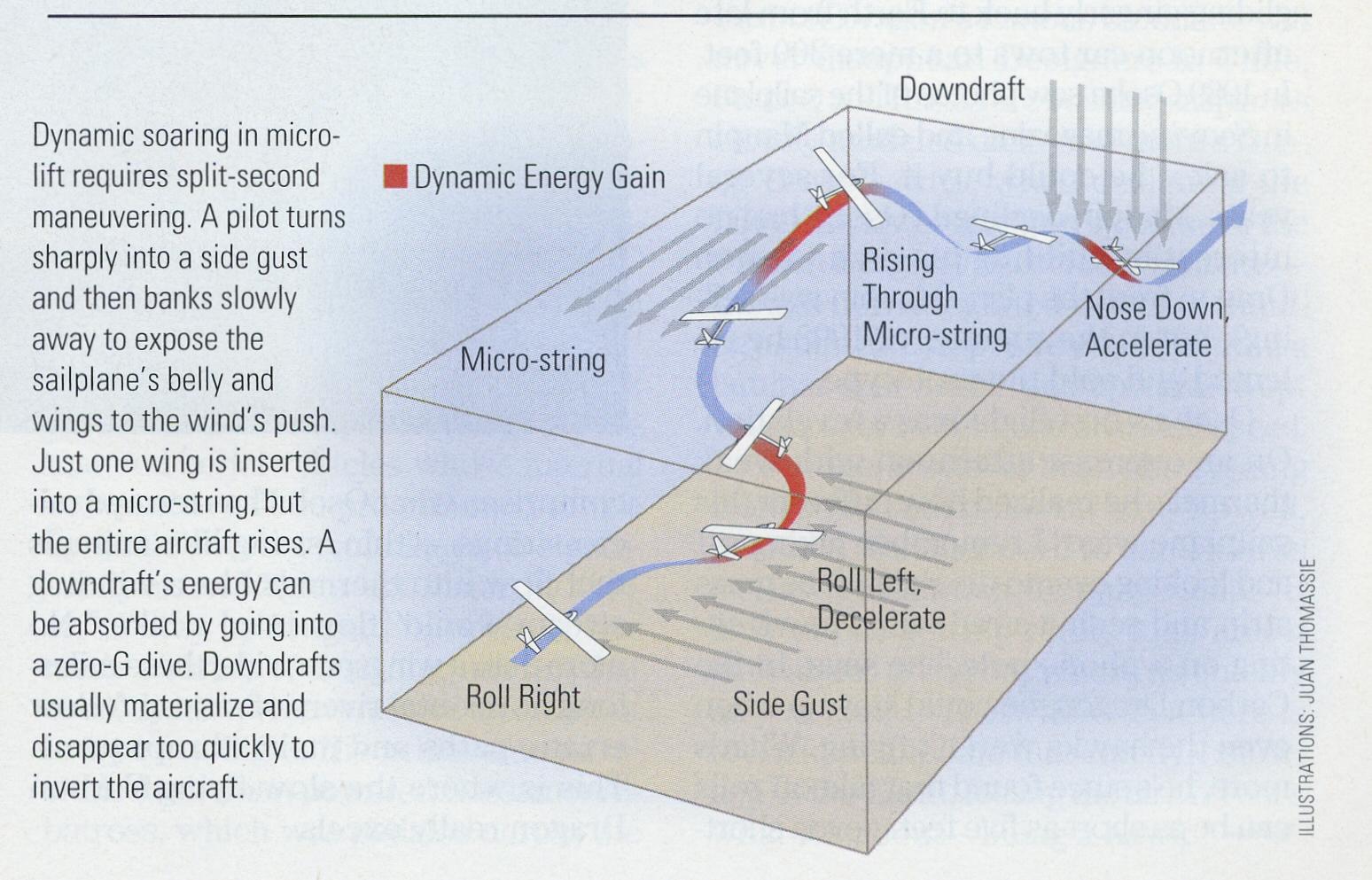
When the Carbon Dragon first appeared in the late 1980s, its balsa wood construction and dope-coated wings gave it the appearance of an oversize stick-and-paper model. But Gary Osoba, who started entering it in soaring contests in 1994, proved it was no toy; the sailplane could climb three to four times faster in thermals than other sailplanes and beat them on distance by margins of two to one. The Carbon Dragon could also get aloft two hours before other sailplanes could, and remain there much longer—usually until the sun went down or until, after seven, eight, or nine hours, the pilot had to relieve the pressure in his bladder.
Though Maupin’s team finished the prototype in 1987, downturns in Maupin’s health kept the craft grounded for most of the next six years. It spent just 10 hours aloft during that period, mostly gliding gingerly back to Earth from late afternoon car tows to a mere 300 feet. In 1989 Osoba saw photos of the sailplane in Soaring magazine and called Maupin to ask if he could buy it. For several years, Maupin declined (Osoba had no interest in building his own Carbon Dragon from the plans Maupin was selling), but in the summer of 1993 he relented and sold the prototype.
Osoba’s first flight was a revelation. On an overcast afternoon with weak thermals, he realized how different this sailplane was. “I remember taking off and looking over to the right of the grass strip and seeing a red-tailed hawk sitting on a phone pole,” he says. In the Carbon Dragon, he could stay up when even the hawks weren’t flying. What’s more, he’s since found that takeoff rolls can be as short as five feet—even shorter if the wind is blowing strongly enough. All he has to do then is wait for a gust and pull back on the stick. In the right winds he has been able to settle the glider on the ground vertically, and on occasion land while drifting backward.
But by themselves, mere random gusts aren’t enough to keep a micro-lift sailplane in the air. Micro-lift also comprises what Osoba has termed micro-strings—“thin, string-like animals that flow into thermals like a winding stream would [flow into] a lake.” No more than a wingspan wide, these miles-long horizontal rivers of air can follow erratic paths and make abrupt turns. This is where the slow-flying Carbon Dragon really excels.
When he finds a micro-string, Osoba immediately slips gently into it until his one wing is completely inside. “You can rapidly roll into it and create 2 Gs on that wing relative to the other wing,” he says. “Now it’s not sustainable because you’re not going to do a barrel roll…. What you do then is you roll back out of [the micro-string] at a more gentle rate into the relative sink and reaccelerate, and then you come back and you roll in and out, in and out of the edge of this shearing event, feeling your way along it.” By continually slipping between the different air masses—essentially doing in a horizontal plane the same thing an albatross does in a vertical one—Osoba has been able to fly into the wind for as long as 20 minutes without losing altitude, and at times even gaining some. Osoba will even avoid looking at the ground or clouds for fear they will subconsciously influence his direction. At other times, he flies with his eyes closed to better sense the air. (“Jim Maupin never envisioned the Carbon Dragon being used in this way,” he says. “[Dynamic soaring] arose after we started exploring with it.”)
Because its long, lightly loaded wings act like a magnifying glass that enables the pilot to sense the slightest change in speed, pressure, or lift, the sailplane can also confer advantages on pilots who use it to soar conventionally in thermals. “When you cross the core you can feel it in your wings,” says Osoba. “I would toss out a Kleenex and it would stay centered in the core. And I would just plant my wingtip, pointing it at the Kleenex and get tighter and tighter.”
New Hampshire hang glider pilot Steve Arndt says his home-built Magic Dragon—he added winglets, stretched wings, and a graphite shell, and made other modifications to Maupin’s basic design—can fly 80-foot-diameter circles in thermals, compared to at least 300 feet for a fiberglass ship. “It flies so slow in turns it looks like the inside wing is going backwards,” he says. The small turning radius enables Arndt to fly wingtip to wingtip with vultures in rising air. “They’re always looking for other soaring creatures,” he says. “Once they get used to you, they’ll fly right with you.”
Osoba is now teaming with Kiceniuk and Paul MacCready to develop two unmanned aerial vehicles whose internal computers will be programmed to use dynamic soaring techniques to significantly extend flights—go faster, fly higher, or stay up longer. MacCready has made a career of designing aircraft that embody his unconventional ideas about low-power flight. His achievements include the human-powered Gossamer Albatross, which was pedaled across the English Channel in 1979 (it’s now enshrined in the National Air and Space Museum’s Steven F. Udvar-Hazy Center); the solar-powered Solar Challenger, which accomplished the same feat in 1981; and Helios, a solar-powered UAV that in 2001 flew to nearly 97,000 feet, snatching the altitude record for a propeller or jet aircraft away from the Lockheed SR-71 Blackbird.
Because building a Carbon Dragon is so labor-intensive (up to 3,000 man-hours or more), only nine are known to be flying worldwide. Just 10 others are under construction, and because Maupin’s family stopped selling plans a few years ago, it’s unlikely that many more will be built (though Steve Arndt says that old blueprints are available through the Sailplane Homebuilders Association). Even so, says Osoba, the Carbon Dragon’s famous bloodline will never disappear. Designers in Chile, France, and Russia are building sailplanes closely modeled on it. And there’s Danny Howell, who, when designing the LightHawk was inspired by some of the Carbon Dragon’s best characteristics—though he’s integrated newer technology such as composite construction, a laminar-flow airfoil, and upward-swept wingtips for better control at stall speed.
“For me, it’s never been about going from point A to point B,” says Howell, who as a teenager used to band hawks at Hawk Mountain, Pennsylvania. “It isn’t about getting really high and it isn’t about going anywhere as quickly as you can…. The whole idea here is to build a sailplane that can fly…slow, nap of the Earth, feeling the air…. That’s what it’s about—being a hawk.”